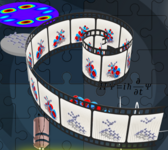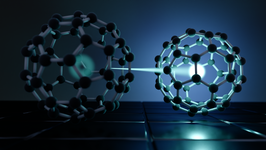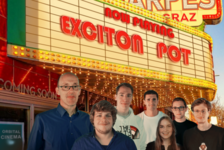News
How do you film electrons? (05.04.2024)
As part of the NAWI Graz Faculty Club on Friday April 5th, 2024, I will give the lecture “How do you film electrons in molecules? And what can we learn from this?” The lecture will take place at 12:15 p.m. in HS 05.01 at Universitätsplatz 5/EG (Uni Graz) and is aimed at all interested students from all institutes of the NAWI faculty and interested parties beyond!
Excitons imaged (19.03.2024)
In the work "Disentangling the multiorbital contributions of excitons by photoemission exciton tomography" published in Nature Communications, we, together with experimental groups from Göttingen and Kaiserslautern, show how excitons in fullerenes (C60 molecules) can be imaged using photoemission orbital tomography. And all of this with a femtosecond time resolution! Immediately after the exciton is generated by light, it spreads into two or more molecules, but within a few femtoseconds the exciton shrinks back down to a single molecule.
Quantum cinema premiered (31.10.2023)
With a publication in Physical Review B, the Graz "Orbital Cinema" team made a successful start to the ERC-synergy project and were able to lay an important foundation for their further plans. Optical excitations of molecules are theoretically described by correlated electron-hole pairs, so-called excitons. Such quasiparticles are particularly important for understanding the fundamental processes in solar cells or light-emitting diodes, but their description using orbital tomography has not yet been possible. This gap has now been closed with the current work, which represents an important step for the planned research on optically excited systems and a successful premiere for “Orbital Cinema”.
Targetting Nano Structures (17.10.2023)
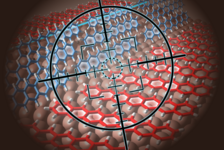

On nanometer-patterned templates formed by alternating stripes of copper and copper-oxide, the electronic properties of organic semiconducting molecules can be deliberately tailored. This could recently be demonstrated for the chain-like moelcule heptacene in a joint publication with the group of Martin Sterrer in the Journal of Physics: Condensed Matter.
Spin me round (26.6.2023)
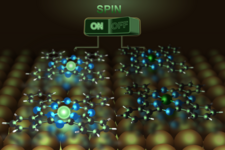

A metal-organic complex cannot decide which spin state to choose. Controlling the magnetic properties of the organic molecule Ni-tetraphenyl-porphyrine adsorbed on a copper srface is in the focus of an article which has been published in Advanced Science (DOI: https://doi.org/10.1002/advs.202300223).
POT detects molecular bend (14.11.2022)
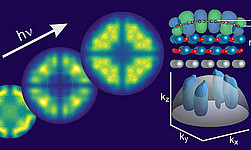

Photoemission-Orbital-Tomography detects the bend of the molecular backbone of a Pi conjugated molecule upon adsorption on a MgO surface. This work under the lead of Martin Sterrer has now been published in Phys. Chem. Chem. Phys.
ERC synergy grant funded (25.10.2022)
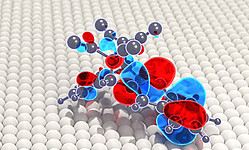

The European Research Council (ERC) has funded our project „Orbital Cinema“ with a prestigious synergy grant. In our project, we (Stefan Tautz, Ulrich Höfer, Rupert Huber and myself) will for the first time record the motions of electrons in molecules in space and time on their intrinsic length and time scales in slow-motion videos. This will allow us a direct view on the inner workings of quantum leaps and charge transfer processes and to reveal how chemical reactions can be controlled by electromagnetic fields and light waves.
Momentum matters (Sep. 28th, 2022)
Electron orbitals show where and how electrons move around atomic nuclei and molecules and are decisive for the prediction of chemical bonding. Only if the orbitals match in space and energy can they be combined thereby forming a chemical bond. In a paper published in Nature Communications, we have now shown that also the orbital’s momentum distribution is important to understand the bonding between organic molecules and metallic surfaces.
Sigma-Orbitals from POT (22.07.2022)
In a paper published in Science Advances, we have demonstrated how sigma-Orbitals can be imaged with photoemission orbital tomography. Such orbitals are particularly relevant for bonding to hydrogen atoms in poly-cyclic hydrocarbons and are therefore relevant for hydrogen storage applications. Our pape rhas also been covered in ChemistryWorld.
Inspired by nature
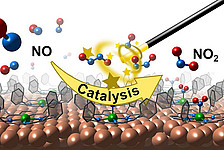

In collaboration with two experimental groups from Germany and Italy, we have investigated tetrapyrrol-complexes, that exhibit a Ni metal center which is frequently found in nature and responsible for their enzymatic activity. In our work, these organic molecules are adsorbed on a copper surface which brought them into an unusual and catalytically active state. This allowed us to study the reaction of nitrogen-monoxide (NO) to form NO2 and N2O which is catalytically activated by the Ni-center. Publication: Angewandte Chemie Int. Ed. (2022).
Photoemission Tomography Workshop
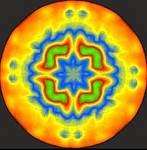

From October 25th to 27th 2021, the International WE-Heraeus-Seminar "Photoemission Tomography: Applications and Future Developments" will take place as a hybrid workshop at the Physikzentrum in Bad Honnef, Germany. Find out more about the topic and invited speakers on the Workshop's webpage and register as participant until September 5th 2021.
Momentum Microscopy at Work
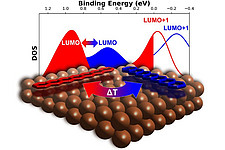

We succeeded in analysing the adsorption of the seventh member of the acene family (heptacene), and demonstrate how its electronic structure varies with the orientation of the molecule on the Cu substrate. Boné et al., J. Phys. Chem. C 125, 9129-9137 (2021).
Ultrafast in Space and Time
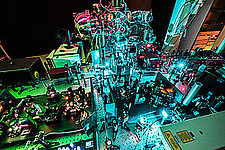

In a collaboration with researchers from the University of Marburg and the Research Center in Jülich, who combined state-of-the-art methods used in laser and electron spectroscopy, we observe electron dynamics in molecules by recording orbital images with an extremely high temporal resolution. Wallauer et al., Science 371, 1056-1059 (2021).
Charge makes the difference
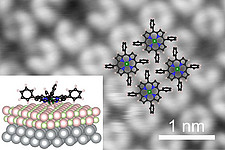

A recent paper published in collaboration with the Surface Science group of the Univesity Graz in Angewandte Chemie (International Edition) demonstrates how the self-metalation reaction of porphyrin molecules on magnesium oxide surfaces can be controlled via their charge state. Egger et al., Angew. Chem. Int. Ed. 60, 5078-5082 (2021).
Superaromatic or not?
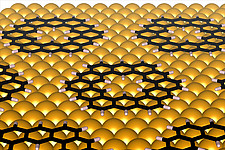

In a collaboration with experimentalists from the Marburg, Jülich and Graz, this question could now be answered for the molecule "kekulene" by theoretical predictions from Puschnig's electronic strucutre theory group. Haags et al., ACS Nano 14, 15766-15775 (2020).
Control over interfacial charge transfer
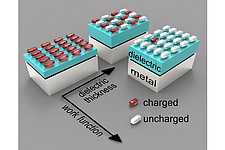

In a joint project with the Surface Science group of the University Graz, we have shown that the charge transfer into organic molecules through ultrathin dielectric interlayers via electron tunneling can be precisely controlled. Hurdax et al., Advanced Materials Interfaces 7, 2000592 (2020).
Nano-Graphene formed on Copper
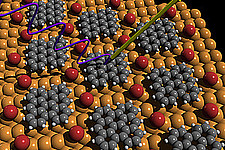

Searching for the method to identify reaction intermediates and products always has been and still remains a Holy Grail of analytical chemistry. Together with experimentalists from Graz and Jülich, we use photoemission tomography to reveal the exact chemical and electronic structure of the reaction product formed by thermally annealing a precursor molecule on a copper surface and identify it as "nano-graphene". Yang et al., Nature Communications 10, 3189 (2019).
